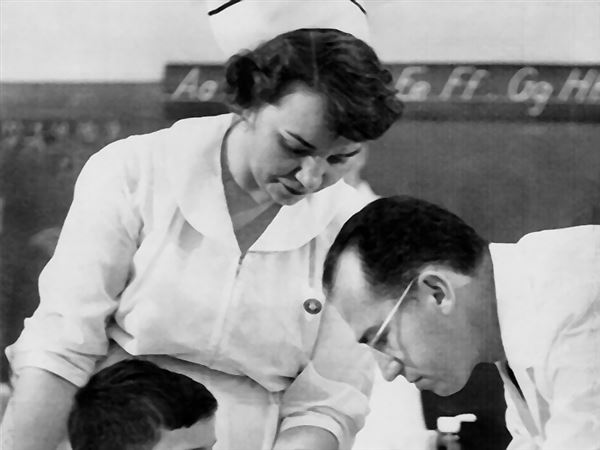First of five parts.
It was over in 8 seconds.
Lying on a gurney at Western Psychiatric Institute and Clinic, Anne Pursley had just experienced her 10th electroshock treatment. A psychiatrist had put a black paddle against her right temple and jolted her brain into a seizure.
Unconscious and with her muscles paralyzed, the only sign of what the 78-year-old Beaver Falls woman was going through was the grimace she made as her facial muscles contracted, and the twitching of her right foot, the one part of her body that hadn't received anesthesia because a blood pressure cuff squeezed her right ankle.
Mrs. Pursley had fallen into a deep depression after her youngest daughter and her second husband both died within the past three years. Suffering from bipolar illness most of her adult life, she had finally agreed to try this scary-sounding procedure.
For her and for anyone watching, it was far less dramatic than they might have imagined.
Many people associate electroshock -- now known as electroconvulsive therapy, or ECT -- with the 1975 movie "One Flew Over the Cuckoo's Nest," in which Jack Nicholson's character is held down by two burly men as his body bucks and heaves and he bites down on a mouthpiece after the electroshock paddles are activated.
More recently, Claire Dane's character in Showtime's "Homeland" received an ECT treatment to help control her bipolar disease. The depiction is much closer to Mrs. Pursley's real-life experience, except that it also shows Ms. Danes' whole body quivering after the electricity is applied.
Except for her mildly twitching right foot, which is used as an indicator that the seizure is occurring, Mrs. Pursley was utterly still because of the succinylcholine paralytic that anesthesiologist James Krugh had given her. Unlike Mr. Nicholson's character, she also was unconscious.
She has not suffered the kind of memory loss that electroshock patients did 40 years ago. In that era, said LalithKumar Solai, the chief of geriatric psychiatry at Western Psych, "we used to use sine wave electricity, which caused many more memory problems. The pattern of the sine wave was broader and caused more cognitive damage, and that's why there were more memory issues. Now there is a much narrower pulse wave."
Most medical students who visit the ECT clinic to observe a procedure "have this dramatic view after seeing 'One Flew Over the Cuckoo's Nest' and then they'll see the real thing and they'll say, 'That's it?' "
As for Mrs. Pursley herself, she told a nurse before the procedure, "I was thinking if there was one word to describe what this does, it would be 'revive.' "
She got her 10th treatment at about 10:45 a.m. on Oct. 24. By 11:30, she was conscious, sitting up in a chair, and saying "That was one of the easier ones."
Another common misconception, Dr. Solai said, is that ECT is rarely performed. His clinic, one of the larger operations in the nation, conducts more than 300 electroshock procedures per month. The compact set of rooms runs like an assembly line, with one set of patients being prepped with IV lines as another one is getting the treatment and still others are coming back to consciousness in a recovery area.
At the same time, it is important to point out that ECT is not a first-line treatment for depression. Most people with chronic depression take medication or meet with psychotherapists -- if they seek help at all. ECT and other more experimental therapies are reserved for people with treatment-resistant depression, which affects an estimated 30 percent of those who seek help.
In that group, though, it can be a crucial option. In people who have failed earlier treatments, Dr. Solai said, new medications work only 50 to 60 percent of the time, while ECT achieves a response in nearly 80 percent of patients.
Mysterious mechanism
Doctors are still not sure why ECT works.
The idea for it came from observations in previous centuries that people who had epileptic seizures often reported afterward that they felt happy and optimistic.
The first attempts to build on that insight employed insulin comas to induce seizures, which killed up to 10 percent of the patients. Then electricity was used, and the procedure has been steadily refined since then.
Doctors know that people with chronic depression have an imbalance of neurotransmitters, the chemical messengers the brain uses to function.
"Crudely put, ECT is almost like a restart button or jump starting a car," Dr. Solai said. "The patient is unable to restabilize that chemical imbalance, but when you're flooding the brain with chemicals, you're giving it an opportunity to reset the balance."
Frank Lotrich, the psychiatrist who administered Mrs. Pursley's ECT, said the seizure "is your brain doing exercise like curls," which is why they administer oxygen to patients during the procedure.
A recent study in Scotland did functional brain imaging of nine severely depressed patients before and after they received ECT and found that a part of the left frontal cortex was overconnected with other brain regions in the patients before treatment, but that afterward, that synchrony was reduced and their symptoms sharply improved.
Western Psych currently uses a series of ultrabrief electrical pulses of three-tenths of a millisecond to trigger seizures in patients.
"It's much safer," Dr. Solai said. "For you to have a seizure, you just need the electricity to fire and once the neurons in the brain start firing, it will induce all the other neurons to fire."
He thinks the quicker pulses may also reduce memory loss, which now seems to be limited to the moments just before and after an ECT procedure. Yet even those momentary lapses can be upsetting to patients.
Cheryl Tomlin, a Wilkins woman who received ECT treatments at Western Psych three years ago, remembered that there were three occasions when she couldn't tell a nurse right after ECT what date it was. "I cried, it was so disturbing," she said.
On the other hand, she has been able to stay out of the hospital since then with a combination of medication and "interpersonal and social rhythms therapy," a treatment pioneered in Pittsburgh that emphasizes adhering to regular daily activities such as mealtimes, exercise and sleep.
That puts her among the two-thirds of patients who are able to avoid getting depressed again as long as they get good followup treatment. The typical relapse rate had been 50 percent within a year of ECT, Dr. Solai said, but doctors here have cut that to about a third by combining antidepressants with a low dose of the mood stabilizing drug lithium, which seems to have an additive effect.
Anne Pursley's story
Mrs. Pursley has struggled with bipolar disease for most of her adult life.
Bipolar disease differs from so-called unipolar depression because patients can boomerang between highly energetic manic behavior and episodes of deep lethargy and feelings of worthlessness. As bipolar patients become older, though, they typically have more episodes of depression than mania, said Charles Reynolds, a University of Pittsburgh psychiatrist who specializes in older patients.
That is exactly what happened to Mrs. Pursley, who watched her younger daughter die of a flu infection in 2010, and then lost her second husband last year.
"I could almost rationalize the death of an 85-year-old very sick husband," she said, "but not a 49-year-old daughter. I think about her daily."
The depression struck earlier this year, while she was living alone. "Unless you've ever been in a clinical depression, it's very hard to describe. A young male friend who has depression told me his wife was working, and just doing the daily dishes for two people was the hardest thing of his day. It's like you've got weights in your shoes and you can't move them."
Her older daughter, a pediatrician in New York City, knew she was not doing well, and persuaded her to go there to try an experimental treatment known as TMS, for transcranial magnetic stimulation.
As in ECT, the TMS doctor uses a paddle held against the skull, but the magnetic stimulation is not strong enough to cause a seizure. Still, it has shown some success in helping people with treatment-resistant depression.
Mrs. Pursley said she thinks the TMS was beginning to lift her mood, too, but "I was homesick, and so I probably cut that short too quickly."
Back in Beaver Falls, her mood began to slump again, and soon, her psychiatrist persuaded her to see the doctors at Western Psych, where she reluctantly agreed to try ECT.
The first of her 14 treatments was rough, she remembered, because she had trouble coming out of the anesthesia. "It was like I was swimming in a vat of black tar."
Slowly, though, the treatments began to lift her spirits, and after the final session in November, doctors said they wanted to keep her on ECT indefinitely as a maintenance treatment, eventually scaling back to once a month.
This month, she experienced some side effects from her ECT, especially aggravation of nerve damage in her feet, so she is not sure if she will continue the therapy.
But in either case, she said the ECT has offered her hope for stability after a life punctuated by episodes of mental illness.
Her bipolar disease first emerged in 1965, "which is a date I remember because my husband said he wanted to dissolve the marriage. This came as a complete surprise to me."
Looking back on that time, she thinks her manic behavior may have played a part in the breakup. She particularly remembers one trip they took to the World's Fair in New York, where she organized all their activities in a huge burst of energy. "But the reason I know how high I was is that when we got back home my husband's boss questioned all the local phone calls that had been made on the hotel phone bill. I had been using it like it was my own phone at home, and that was a little bit of a clue that I was manic, but I didn't pick up on it."
Like many others with mental illness, Mrs. Pursley thinks there is a family history, even though it wasn't openly identified. Her mother had bipolar disease, her grandmother may have had it, and an uncle had serious emotional problems. If she did have an inherited vulnerability, the stress of the divorce could very well have triggered her illness.
Other hospitalizations followed in the 1970s, she said, and yet she also managed to earn a bachelor's degree, finish her student teaching -- even though she decided she wasn't suited to be a teacher -- and then hold a fulfilling job for more than 20 years at the Beaver County Office of Aging.
The ECT has made it possible for her to climb out of the deepest depression she has ever experienced, she said.
"I couldn't even pull myself from one room of the house to the next. I couldn't carry on a conversation. It was the most profound depression I'd ever been in. Today, my mood is much better. I do get headaches occasionally, which I think is the result of the ECT. But my mood and disposition are just wonderful."
And she has joined the board of the National Alliance on Mental Illness in Beaver County, where she has slowly begun to talk about her lifelong challenges.
"I'm coming out in a way," she said, "but a lot of people still don't want to hear about your mental illness; they're much more comfortable having you talk about a broken hip."
First Published: December 15, 2013, 4:57 a.m.
















